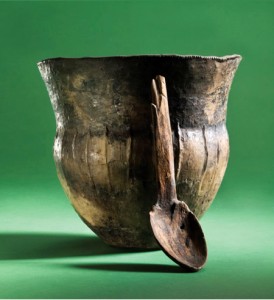
This 6,000-year-old cooking pot and wooden spoon were recovered from the Åmose Bog in Zealand, Denm. (Image courtesy of Anders Fischer)
Apparently it took a little longer than we thought for humans to transition from hunting and gathering to farming and agriculture for survival.
Researchers came to that conclusion after studying the residue found on ancient cooking vessels.
In analyzing 133 ceramic vessels from the western Baltic regions of northern Europe, they tried to determine whether the origin of the food residue came from land, sea or freshwater organisms.
The ancient ceramic pottery from 15 sites dated to around 4,000 BC, about the same time the first evidence of domesticated animals and plants was found in the region.
The researchers found that, despite the onset and rapid move to farming and domestication, humans living in coastal areas still ate a diet rich in fish and other aquatic-based foods.
The cooking pots from these regions contained food residues abundant with a form of carbon commonly found in marine organisms.
Perhaps that isn’t surprising. However, what is interesting is that fish was also a popular food staple for those living further inland, too. Almost one third of the pottery found at sites further from the coast contained residue from aquatic organisms, probably freshwater fish.
“This research provides clear evidence people across the western Baltic continued to exploit marine and freshwater resources despite the arrival of domesticated animals and plants,” says study lead author Dr. Oliver Craig of the Department of Archaeology at York. “Although farming was introduced rapidly across this region, it may not have caused such a dramatic shift from hunter-gatherer life as we previously thought.”
The researchers say this is the first large-scale study to combine a wide range of molecular evidence and single-compound isotope data, which indicates whether the material processed in ancient ceramics was of terrestrial, marine and freshwater origin. They believe their work provides a template for future investigations into how people used similar cooking vessels in the past.





















Comments are closed.